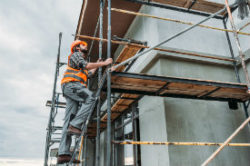Construction Job Site Accidents

Construction job sites are dangerous places to work. In 2019, 20% of worker fatalities were in construction. Many of the accidents on a construction job site are due to negligence, unsafe worksite practices, improper use of tools and equipment, and lack of protective safeguards. Leading causes include the ‘fatal four’: falls, struck by object, electrocution and caught-in/between.

Construction worker climbing scaffolding.
Most common construction job site accidents
- Falls from heights are one of the most common types of accidents and include scaffolding accidents, ladder accidents, roofing accidents, crane accidents and other falls from heights. Scaffolding accidents, for instance, can be caused by improper construction or negligent maintenance; ladders may be defective or improperly maintained.
- Struck-by objects account for 8.2% of worker deaths in construction. This includes objects that are falling, flying, swinging or rolling that could injure a worker. Proper training and knowing how to use the equipment and machinery can help prevent accidents of this type.
- Electrocutions account for 7,3% of worker fatalities. This happens when the person, tool or equipment comes into contact with power lines or exposed electrical sources. Workers may not be aware of all energized power sources, from overhead and underground power lines to damaged receptacles and connectors.
- Caught-between accidents account for 5.1% of worker deaths in construction. These are accidents where a worker’s body part is caught, crushed or squeezed between two or more objects that happens as a result of collapsing materials, body parts pulled into unguarded machinery and equipment rollovers.
- Crane or hoist accidents and forklift accidents (heavy machinery). Construction job sites have lots of heavy machinery (graders, dump trucks, backhoes, etc.) needed to complete the work. Accidents can be caused by malfunctioning or defective parts and equipment, lack of training, operator error and other factors, leading to very serious accidents and fatalities.
- Gas leaks, fires and explosions. Construction job sites often contain hazardous chemicals and/or hazardous conditions such as exposed wiring, leaking pipes and flammable chemicals that can lead to fires and explosions.
- Trench accidents. Should a trench collapse or an accident occur within a trench, construction workers can be trapped making it difficult to get them out.
There are many other types of accidents that occur on the construction job site; these are just examples of what could happen.
Construction accident injuries range from minor to life-threatening and fatal.
- Cuts or lacerations from exposed nails, tools, machinery, etc.
- Broken or fractured bones
- Head or traumatic brain injuries often happen after a fall
- Amputation of a finger, toe, or limb
- Eye injuries or loss of vision from shrapnel, dangerous chemicals or gases, etc.
- Loss of hearing from the loud noises on construction sites or failure to wear hearing protection
- Paralysis and other spinal cord injuries, especially from falls
- Toxic exposure to chemicals
- Burns from fires, explosions, or electrocutions
Questions? Call us at (877) 284-6600, Chat Online or use our Text Us widget.
Safety Considerations for Construction Job Sites
- Use caution around fall hazards. Safety systems should be in place to prevent falls, which might include guardrails, safety nets, safety cords and personal fall arrest systems.
- Never use damaged equipment. Always check your equipment before going out on the job site. You might find a worn-out cable, worn-out cords or other cracks and tears that could lead to serious accidents.
- Check equipment before getting in and out. That means checking boot and gloves for slippery substances, getting a secure foot or hand hold before climbing up. Use caution when climbing on and off equipment.
- Know what personal protective equipment to wear. What you wear will be dependent upon the job you are doing. Be sure that it fits well, too.
- Be careful when loading or unloading equipment. Ramps should be straight and cleared. Have another worker spot you. Use proper tie-down procedures.
- Ladder and stairs climbing hazards. Be sure to inspect a ladder or stairs before stepping on them. Check for damaged, loose, worn, weak and other broken spots. Keep them clean, uncluttered and dry. Make sure you are using the proper ladder for the job..
- Be aware of your surroundings at all times. Construction job sites often times have multiple companies doing different parts of the work. They may not be aware of you. Other dangers to be aware of are falling objects and getting run over or hit by some of the heavy machinery.
- Reinforce safety at all times
Need more information?
SERIOUSLY INJURED IN A CONSTRUCTION SITE ACCIDENT?
If you or a loved one has been seriously injured in a construction site accident where your injuries were due to another’s negligence, contact Nash & Franciskato at (877) 284-6600. We have a successful track record of helping accident victims collect the compensation they deserve.
One of our experienced staff will speak with you personally and will provide you with a free, no-obligation review of your case. Having an attorney who is your advocate can offer you peace of mind during your recovery.
INJURED? START YOUR FREE CASE EVALUATION TODAY
RESOURCES FOR YOU
If you would like to receive news and blog updates on a regular basis, sign up to receive our email newsletter. Your email address will only be used to send you our newsletter and respond to inquiries.
Past results afford no guarantee of future results and each case is different and is judged on its own merits. The choice of a lawyer is an important decision and should not be based solely on advertisements.
Editor’s Note: This post was originally published October 18, 2019. It was reviewed on March 21, 2023 and updated for content and accuracy.
Related

